|
 |
The Memotech MTX Series |
 |
MEMOTECH
Multi-Effect Video Wall - Examples
The Memotech Video Wall was very successful and was
installed in many high profile venues, including the
Hammersmith Palais in 1987, with an upgrade in 1990. At that time, this was
the biggest club Video Wall in the UK, consisting of 2, 5x5 matrix displays. You can read about it in
Issue 52 of Lighting and Sound International in the
Library pages.
There is a small "Memotech History of Multimedia"
presentation by Geoff Boyd, available
on his web pages
here.
|
The Natural
History Museum
Geoff's presentation shows the
Video Wall at the Natural History Museum which used
Memotech technology, at least when it was installed.
(See Slide 7). The photo in the
presentation is of Nick Moore's "Kaleidosphere". The slide does not make clear that much
of the effect was achieved by the
clever use of
mirrors which gave the impression that the Video Wall
was much larger than it actually was, the active
video wall area was "only" a 4x5 matrix of displays. If you look
closely at the photos below, (courtesy of the Natural
History Museum), you can see that much of the "video wall"
effect is achieved using mirrors. A close up of this
effect can be seen in
this photograph on Flickr, taken by Alan Wilkinson,
courtesy of Alan, you can find a copy of the picture
here. Alan also kindly put me in touch with the
original system installer (Brian Pipe).
Nick Moore and his company,
Brilliant Adventures, have specialised in optical
illusions using mirrors since 1985. In 1991, Moore
designed and installed the "Kaleidosphere"
at the Natural History Museum, the Kaleidosphere also
featured on the BBC's Tomorrow's World
programme the same year. You can view a clip of the
programme on
YouTube. However, I believe that the "Kaleidosphere"
was only the optical elements, i.e., the mirrors used in
this impressive display.
When looking for more
information on this display, I was pointed in
the direction of
Neal Potter's website.....
[27/08/2015 :
hyperlink to neilpotterdesign.co.uk removed, I
believe that Neil Potter has now retired and the
website is closed]"In 1990 Neal
Potter was asked to head up the design team for
the proposed
Ecology Gallery at the Natural History
Museum. The gallery was opened by HRH The
Princess of Wales in 1991 and set the standard
for the upgrading of the Natural History Museum
during the 1990's."
[07/05/2018 :
hyperlink to http://www.nhm.ac.uk/visit-us/galleries/green-zone/index.html removed,
the link is now dead]
There, the Video wall display is referred to
as the "Quadrascope at the centre of the
gallery. It tells the story of the Earth's water
cycle." It is also referred to in different
articles as the "Quadrosphere". |
|
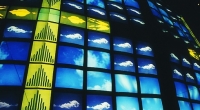 |
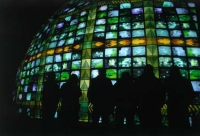 |
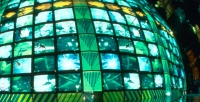 |
|
Photo :
Natural History Museum |
Photo :
Neil Potter Design |
Photo :
Natural History Museum |
|
|
|
|
|
The Video wall
hardware was actually installed by Video Power
Multimedia Ltd. then run by Brian Pipe, although
the company has since been dissolved, the
display is still going strong, though I doubt
that it still uses Memotech hardware. Brian has
confirmed that the Video wall hardware was
sourced directly from Memotech and used an MTX
series computer, he also recalls some of the
detail of the system configuration :
"It was a 4 x 5 configuration using Barco
SCM3240 32" diagonal CRT videowall display 4:3
aspect ratio monitors within the bell mouthed
mirrored tunnel that we called a kaleidosphere
The 16:15 was adjusted out to 1:1 by a series of
light boxes around the outside of the monitors."
[Specs for the Barco SCM3240: 15.7kHz (H),
50-60Hz (V) scan rates, 600 pixel horizontal
resolution]
(Some of the Video wall information comes courtesy
of Geoff Boyd, 09/11/2012, from his recollection of the
Memotech Video wall business)
(Other contributions from Alan
Wilkinson,10/01/2013 and Brian Pipe 03/02/2013) |
|
|
Further Details about the NHM
Installation - courtesy of Chris
Russell
In an attempt to get some
technical details of the Memotech
Water Cycle
Video Wall display in the
Natural History Museum,
I contacted the NHM and made a general enquiry by e-mail
in August 2015. I was very pleased, and not a little
surprised, to receive a reply from Chris Russell, a
member of the NHM's "Special Effects Section". Chris has
been involved with the Quadroscope since it was first
installed and actually programmed it at its
installation.
Chris kindly sent me scans of some
Videowall sales literature that I had not seen
before, you can find them on my
Videowall Index page.
Chris also gave me some interesting information
on how the Quadroscope developed after its
original installation . . . .
"I work as
part of the Special Effects team here at the
NHM, and have been involved with the Quadroscope
since it was first installed - it was me that
actually programmed it and we have since
upgraded/refurbished it twice since then.
The Ecology gallery opened in the early
1990’s, and although some changes have been made
to it since, the Quadroscope remains one of our
most memorable exhibits.
In its
original form, the installation consisted of a
5*4 wall of Barco monitors, with the content
supplied to the Memotech processor from a Sony
laserdisc player. As far as I can remember, the
Memotech controller took a composite video
output from the laserdisc player, and then
monitored the RS232 output of the player to
receive frame number information. At certain
frame numbers, the various effects/freeze frames
were triggered. Around the outside of the
monitor wall are a series of backlit graphic
panels that light up at various points in the
sequence to re-enforce the ‘journey’ round the
Water Cycle.
The hardware was purchased
from a company called Market Factor/Videopower,
at an original cost of £16,200, and consisted of
a Memotech 2000 controller, 20 channels of DDFS
framestore, cabling, and a Memotech MTX512
computer with framecode reader.
I have
found some of our
original
promotional Memotech brochures and have
scanned some of them for you.
In 1997, as
it became difficult for us to maintain the
original Barco monitors, they were replaced with
Hantarex screens, but the controller remained
until we refurbished parts of the gallery in
2003 At this point, we retained the monitor
installation, but the Memotech system was
replaced with Electrosonic C-Through software
and Imagestar controller.
This system
remained in place until 2013. At this point it
was becoming more difficult for us to keep
repairing the CRT monitors, so we decided to
replace them with a front projection system
using a Projection Design F32 projector. I
re-purposed the content using Adobe After
Effects software to retain the look of the
original video wall (including keeping the
original ‘grid’ appearance), and recreated most
of the effects/transitions from the original
installation, with a few enhancements. We felt
it important to try and keep the look and feel
of the original installation, but in a much
easier to maintain way.
As it currently
stands, the content is run from a Brightsign
HD1020 player, that is controlled by an in-house
custom built controller that also triggers the
light boxes at the correct points in the
sequence. Unfortunately, we are unable to keep
old technologies that we replace from the
galleries, so both the Memotech system and its
Electronic successor would have been sent for
recycling when they were removed. "
Chris
Russell, NHM, August 2015 |
|
|
|
The
Photo Centre of Oman
The
April
1992 edition of Light and Sound International
reported that "Memotech Computers recently
supplied a 12x8 System 2000 Video Wall to Photo
Centre of Oman. . . . The system comprises 96
Barco SCM2840 MK2 monitors combined with
Memotech Video Wall electronics."
|
The Hammersmith Palais
The
July 1987 edition of Light and Sound International
had a feature on the refurbishment of the
Hammersmith Palais which included a brief
mention of the installation of two 5 x 5 Cameron
(Memotech) Video Walls.
The
April
1990 edition of Light and Sound International
had an article which described the lighting
upgrades to the Palais done in 1990 when the two
smaller Video Walls were combined into a single
10 x 5 Wall - then the largest club Video Wall
in the UK.
Tecterran have an
article
on their website which describes
Bit Bopper, a "Digital
Interactive Multimedia Entertainment System"
that used Acorn RISC processors to generate
audio synchronised computer graphics. The
article describes Bit Bopper
being used at the 1990 Disco Mix Championships
held at the Hammersmith Palais to drive a "huge
50 screen video wall" - almost certainly the
Memotech Video Wall.
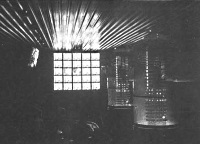 |
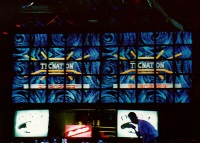 |
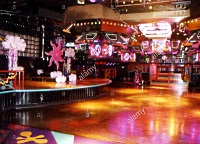 |
| Poor quality photo from L&SI showing
one of the 5 x 5 Video Walls installed
in 1987 |
Photo from Tecterran showing the
single 20 x 5 Video Wall in 1990 - using
the same Cameron hardware. |
A "stock" photo from alamy.com from
around the same time, showing the inside
of the Palais with the Video Wall |
|
| |
| |
|